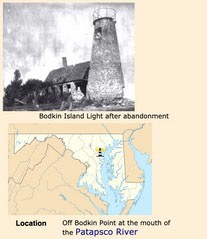History
From Wikipedia: The Bodkin Island Light was a small lighthouse on the Chesapeake Bay, first erected by Thomas Evans and William Coppeck in 1821. Built on Bodkin Island, it was the first lighthouse in Maryland. The lighthouse was constructed to aid shipping entering Baltimore. The station with a 35-foot (11 m) stone tower with attached one-story keepers dwelling was formally inaugurated in January of 1822, using thirteen lamps purchased from Winslow Lewis.
Due to poor construction, the lighthouse was plagued with problems during much of its brief existence. In 1856, it was replaced by the Seven Foot Knoll Light in the Patapsco River. A fisherman is said to have lived in the dwelling for a time, but eventually the island was completely abandoned. The old tower collapsed in 1914. Today, Bodkin Island has disappeared, eaten away by erosion. What remains of the site is marked as a "navigational hazard" on sea charts. 
Did you know that during the early 20th century, many Polish and Czechoslovakian people migrated to the Pasadena area to work on the farms during the summer season? There were many Eastern European families that populated the state of Maryland during that time, and because the economy of the 19th century was reliant on slave labor when slavery was no longer in existence, Pasadena farmers needed affordable labor to aid in picking crops. This labor came in the form of Eastern European families who fulfilled a great need during the summer months.
The Pasadena Peninsula had ferries and steamers that people would board when they wanted to go to Baltimore for the day. Remember, there were no highways back then, and what might be a twenty-minute ride on the highway now could have actually taken several hours back then. More often than not a ferry or a steamer would prove to be a quicker route of passage into the city limits.
Imagine the location of Compass Pointe Golf Course. The rolling hills lush greenery are undeniably beautiful, and to think that this lush, green, aesthetically pleasing golf course was at one time a farm may be a bit daunting.
Compass Pointe was once a popular farm known as Bottomley’s Farm. Bottomley’s was a farm whose surroundings were not quite as glamorous as that of the golf course. There were rundown, wooden shanties, and cooking shacks that lined the entry to the berry portion of the farm. Many of the Eastern European families who worked on the farm actually lived in these little shacks. Small hands toiled the land, working in that often unbearable, humid-laden heat that the summer months are notorious for.
 |
A link to books about the Pasadena Peninusula by Isabel Shipley Cunningham |
Pages
- Home
- Event Calendar
- COMMUNITY HALL RENTAL INFORMATION
- Hall Rental Information
- Community Hall Photos
- Location
- Association Information
- About the PRIA
- Membership Form(s)
- Online Payments
- Board Members & Committees
- Current Board Members
- Committees
- By-Laws & Meeting Minutes
- By-Laws (9/8/2021)
- Meeting Minutes
- PRIA Newsletters & Other News
- PRIA Newsletters
- Other News
- Things to do!
- Community Events
- Doghouse Library
- Oyster Recovery Program
- Area Information
- History
- Local Flavor
- County/State Services & Utilities
- State/County Services & Utilities
- Anne Arundel County Newsletters
- Bodkin Tide Information
- Boating Speed Limits-Bay&Estuaries
- DNR-No Discharge Zone Info 6-24-22
- CBF Bay Footprint Calculator
- Classifieds
- Community Photos
- Scenic Photos
- PRIA Event Photos
- Videos
- Directories
- Directory of Registered Residents
- PRIA membership thru 9-15-24
- Pet Directory
- Website Help & Instructions
- Registration instructions
- Website Help/Forgotten Password
- Contact Us
- SEND AN EMERGENCY ALERT
- PRIA Event RSVP & Info

